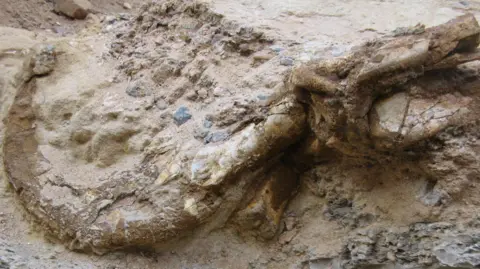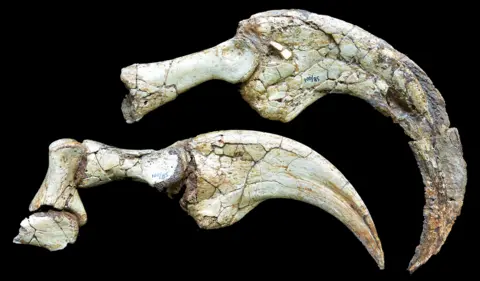Climate and science reporter
 Artist’s impression by Masato Hattori
Artist’s impression by Masato HattoriA rare new species of two-clawed dinosaur has been discovered by scientists in Mongolia’s Gobi Desert.
The species, named Duonychus tsogtbaatari, was unique within a group of dinosaurs called Therizinosaurs, which stood on their hind legs and usually had three claws.
It was medium-sized, with an estimated weight of approximately 260kg.
Researchers believe the species’ long, curved claws and its ability to strongly flex them would have made it an efficient grasper of vegetation.
 Yoshi Kobayashi, Hokkaido University
Yoshi Kobayashi, Hokkaido UniversityTherizinosaurs were a group of either herbivorous or omnivorous theropod dinosaurs that lived in Asia and North America during the Cretaceous Period, which began 145 million years ago and ended 66 million years ago.
They are exemplified by the massive, long-clawed form Therizinosaurus, featured in the film Jurassic World Dominion, and were “awkward looking”, according to one of the study’s authors Dr Darla Zelenitsky, associate professor at the University of Calgary.
The specimen was recovered from the Bayanshiree formation in the Gobi Desert of Mongolia, which dates back to the Late Cretaceous period (between 100.5 to 66 million years ago).
Unesco, the UN’s Educational, Scientific and Cultural Organization, calls the Mongolian Gobi Desert the largest dinosaur fossil reservoir in the world.
The region is an especially important source of fossils from the later Cretaceous period, which is the last of the main three periods of the dinosaur age, representing the final phase of dinosaur evolution.
 Kobayashi et al
Kobayashi et alAt nearly a foot long, the claws themselves were much larger than their underlying bone, the study revealed.
Besides better grasping, the two-fingered hands may have been used for display, digging, or as formidable weapons.
The most famous two-fingered theropods are species within the group tyrannosaurids, which includes Tyrannosaurus rex, but Duonychus evolved its two-fingered hands separately from them and from other two-fingered theropods.
The specimen also preserves the first keratinous sheath of a therizinosaur, an element that covers the claw much like human fingernails, aiding defence, movement, or prey catching.


